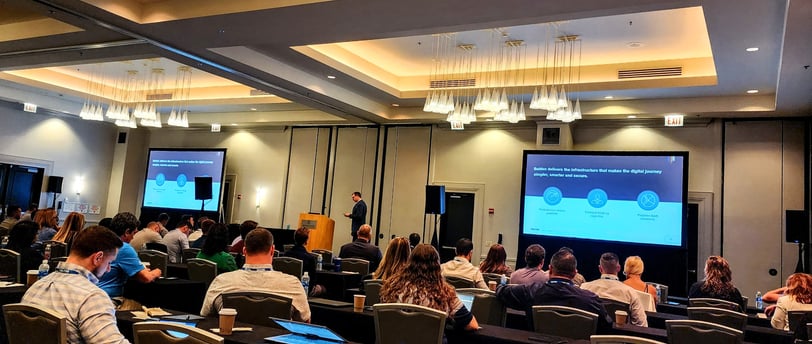
Corporate Event AV Planning
A Comprehensive Guide to Audio-Visual Excellence for your event


Corporate events are a great way to showcase your brand, communicate your message, and engage your audience. However, planning a successful corporate event requires careful attention to detail, especially when it comes to audio-visual (AV) needs. AV equipment can make or break your event, as it affects the quality of your presentations, the mood of your attendees, and the overall impact of your event.
To help you plan a corporate event with AV needs, here are some tips and best practices to follow:
Define your AV goals and budget. Before you start looking for AV equipment and providers, you need to have a clear idea of what you want to achieve with your event and how much you can spend on AV. Some questions to ask yourself are:
What is the purpose and theme of your event? This will help you determine the tone, style, and format of your event. For example, if you are hosting a product launch, you may want to create a buzz and excitement with dynamic visuals and sounds. If you are hosting a training session, you may want to create a conducive and interactive learning environment with clear and engaging audio and video.
What kind of content will you present? Will it include videos, slides, live streaming, etc.? This will help you decide what kind of AV equipment you need and how to display it. For example, if you are showing videos or streaming content, you may need a rear screen projector for better visuals. If you are using slides or other graphics, you may need a front screen projector or a large monitor. If you are using audio clips or music, you may need speakers or headphones.
How many speakers and attendees will you have? This will help you plan the size and quantity of your AV equipment and how to arrange it. For example, if you have multiple speakers or audience questions, you may need a mixer or sound board to balance the sound and control feedback. If you have a large audience, you may need microphones or amplifiers to ensure everyone can hear clearly.
What is the size and layout of your venue? This will help you choose the best location and position for your AV equipment and how to optimize it for visibility and sound quality. For example, if your venue is small or has low ceilings, you may need to use short throw projectors or ceiling-mounted speakers. If your venue is large or has high ceilings, you may need to use long throw projectors or floor-standing speakers.
How long will your event last? This will help you estimate the power consumption and battery life of your AV equipment and how to manage it. For example, if your event is short or has breaks, you may be able to use corded or rechargeable equipment. If your event is long or continuous, you may need to use cordless or battery-operated equipment.
What is your AV budget and how flexible is it? This will help you prioritize your AV needs and negotiate with your AV provider. For example, if your budget is tight or fixed, you may need to focus on the essential AV equipment and look for discounts or deals. If your budget is generous or flexible, you may be able to afford more advanced or customized AV equipment and services.
Choose the right AV equipment and provider. Once you have defined your AV goals and budget, you can start looking for the best AV equipment and provider for your event. Some factors to consider are:
The type and quality of the equipment. You want to choose equipment that suits your content, audience, and venue. You also want to choose equipment that is reliable, durable, and easy to use. You should check the specifications, features, reviews, and ratings of the equipment before renting it. You should also test the equipment before using it at your event.
The availability and reliability of the provider. You want to choose a provider that has experience in delivering similar events and has a good reputation in the industry. You also want to make sure they have enough staff, backup equipment, and contingency plans in case of any issues or emergencies. You should check the credentials, references, testimonials, and portfolio of the provider before hiring them. You should also communicate with them regularly and clearly about your expectations and requirements.
The compatibility and integration of the equipment. You want to choose equipment that works well with each other and with your venue’s existing infrastructure. You also want to make sure that the equipment is compatible with your speakers’ devices and presentations. You should check the compatibility charts, manuals, guides, and tutorials of the equipment before using it. You should also consult with your venue manager and your AV provider about the best way to integrate the equipment.
The cost and value of the service. You want to choose a provider that offers competitive pricing and transparent quotes. You also want to look for any hidden fees or extra charges that may affect your budget. You should compare the cost and value of different providers based on their quality, service, and support. You should also negotiate with them for the best deal and ask for any discounts or incentives.
Communicate and coordinate with your AV team. After you have chosen your AV equipment and provider, you need to communicate and coordinate with them throughout the planning process. Some tips to ensure a smooth collaboration are:
Share your event vision and expectations with your AV team. Let them know what you want to achieve with your event and how you want it to look and sound. Provide them with your event goals, budget, agenda, speaker list, presentation files, logos, videos, etc. Give them feedback and suggestions on their work and listen to their advice and recommendations.
Provide them with all the necessary information and materials for your event. This includes your event date, time, location, duration, audience size, venue layout, power outlets, internet access, etc. Provide them with any special requests or preferences you have for your AV equipment and service. Provide them with any changes or updates you make to your event plan as soon as possible.
Schedule regular meetings and site visits with your AV team. This will help you review the progress of the AV setup, test the equipment, troubleshoot any problems, and make any adjustments as needed. You should schedule at least one meeting and one site visit before your event to finalize the details and confirm everything is ready. You should also schedule a meeting and a site visit after your event to evaluate the performance and collect feedback.
Assign a point person for AV communication. This will help you avoid any confusion or miscommunication between you and your AV team. You should assign one person from your side and one person from their side to be in charge of all AV communication. They should be responsible for relaying information, answering questions, resolving issues, and making decisions. You should also have an emergency contact number for your AV provider in case of any issues during the event.
Prepare for the day of the event. On the day of your event, you need to be ready for any possible scenarios that may affect your AV performance. Some steps to prepare for the day of the event are:
Arrive early and check the AV setup. Make sure everything is working properly and according to your plan. Check the sound levels, lighting effects, video quality, etc., of your AV equipment. Check the connections, cables, batteries, etc., of your AV equipment. Check the compatibility, format, resolution, etc., of your speakers’ devices and presentations.
Have a backup plan for any potential failures or glitches. Have extra batteries, cables, adapters, laptops, etc., on hand in case something goes wrong with your AV equipment. Have alternative content or activities ready in case something goes wrong with your speakers’ presentations. Have a contingency plan ready in case something goes wrong with your venue or audience.
Have a rehearsal or run-through with your speakers and AV team. This will help you familiarize yourself with the equipment, practice transitions, timing, cues, etc., and address any last-minute issues or changes. You should have a rehearsal or run-through at least one day before your event to ensure everything is smooth and seamless. You should also have a brief rehearsal or run-through on the day of your event to refresh everyone’s memory and confidence.
Monitor and adjust the AV during the event. Keep an eye on the sound levels, lighting effects, video quality, etc., of your AV equipment during the event and make any necessary adjustments as needed. You can use a remote control or an app to control some of the AV equipment from a distance. You can also ask your AV team to monitor and adjust the AV equipment for you from backstage or a control room.
By following these tips and best practices, you can plan a corporate event with AV needs that will impress your audience, deliver your message, and achieve your goals.
Yes, you are in the right place to help sort out almost all of these. just Call, Text, or Email us.

